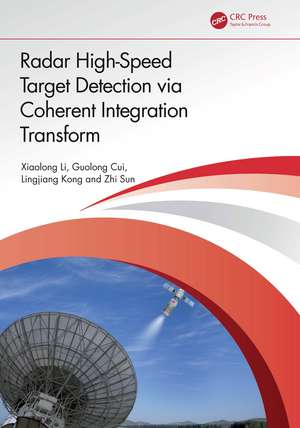Radar High-Speed Target Detection via Coherent Integration Transform
Autor Xiaolong Li, Guolong Cui, Lingjiang Kong, Zhi Sunen Limba Engleză Hardback – 14 noi 2024
The authors present mathematical models and design principles necessary to analyze the behavior of each type of coherent integration transform, and based on this, they introduce and convey new approaches and techniques for designing such transforms, which will help to achieve efficient signal integrators and detectors, especially in the challenging low signal-to-noise ratio (SNR) environments.
The book will be of interest to graduate students and engineering professionals in statistical signal processing, signal detection and estimation, and radar signal processing.
Preț: 793.19 lei
Preț vechi: 967.30 lei
-18% Nou
Puncte Express: 1190
Preț estimativ în valută:
151.78€ • 165.38$ • 127.89£
151.78€ • 165.38$ • 127.89£
Carte tipărită la comandă
Livrare economică 23 aprilie-07 mai
Preluare comenzi: 021 569.72.76
Specificații
ISBN-13: 9781032671765
ISBN-10: 1032671769
Pagini: 312
Ilustrații: 222
Dimensiuni: 178 x 254 mm
Greutate: 0.76 kg
Ediția:1
Editura: CRC Press
Colecția CRC Press
Locul publicării:Boca Raton, United States
ISBN-10: 1032671769
Pagini: 312
Ilustrații: 222
Dimensiuni: 178 x 254 mm
Greutate: 0.76 kg
Ediția:1
Editura: CRC Press
Colecția CRC Press
Locul publicării:Boca Raton, United States
Public țintă
Postgraduate and Professional ReferenceNotă biografică
Xiaolong Li is an associate professor at the School of Information and Communication Engineering, University of Electronic Science and Technology of China. His research interests include radar moving target detection and MIMO radar signal processing, with an emphasis on high-speed maneuvering target detection.
Guolong Cui is a professor at the School of Information and Communication Engineering, University of Electronic Science and Technology of China. His research interests include cognitive radar, array signal processing, MIMO radar, and through-the-wall radar.
Lingjiang Kong is a professor at the University of Electronic Science and Technology of China. His research interests focus on signal processing for radar. He has authored and co-authored more than 150 publications in international journals, conferences, and books.
Zhi Sun is an associate researcher at the School of Information and Communication Engineering, University of Electronic Science and Technology of China. His research interests include weak target detection, time-frequency analysis, and clutter suppression.
Guolong Cui is a professor at the School of Information and Communication Engineering, University of Electronic Science and Technology of China. His research interests include cognitive radar, array signal processing, MIMO radar, and through-the-wall radar.
Lingjiang Kong is a professor at the University of Electronic Science and Technology of China. His research interests focus on signal processing for radar. He has authored and co-authored more than 150 publications in international journals, conferences, and books.
Zhi Sun is an associate researcher at the School of Information and Communication Engineering, University of Electronic Science and Technology of China. His research interests include weak target detection, time-frequency analysis, and clutter suppression.
Cuprins
1. Basic Concept 2. High-Speed Target Signal Integration Processing 3. MLRT-Based Coherent Integration Processing 4. RLVD-Based Coherent Integration Processing 5. KT-MFP-Based Coherent Integration Processing 6. Segmented Processing-Based Coherent Integration 7. SAF-SFT-Based Coherent Integration Processing 8. Coherent Integration with Unknown Time Parameter 9. Fast Non-Searching Coherent Integration Processing 10. STGRFT-Based Integration for Multiple Motion States 11. Multi-Frame Coherent Integration Processing 12. SCRFT-Based Coherent Integration Processing 13. CLEAN-Based Coherent Integration Processing
Descriere
This book offers a systematic presentation of high-speed radar target detection methods using coherent integration transforms, including the signal model, derivations of coherent integration transforms, and definitions of related key concepts.
